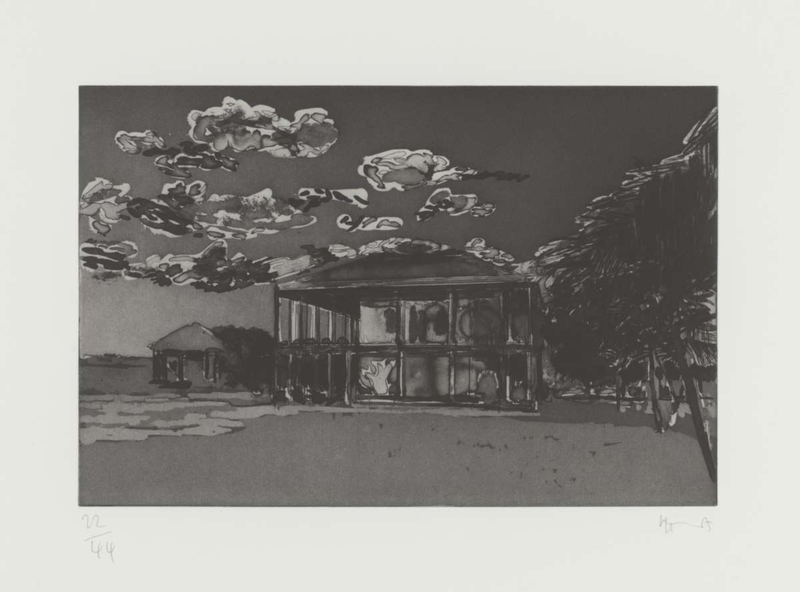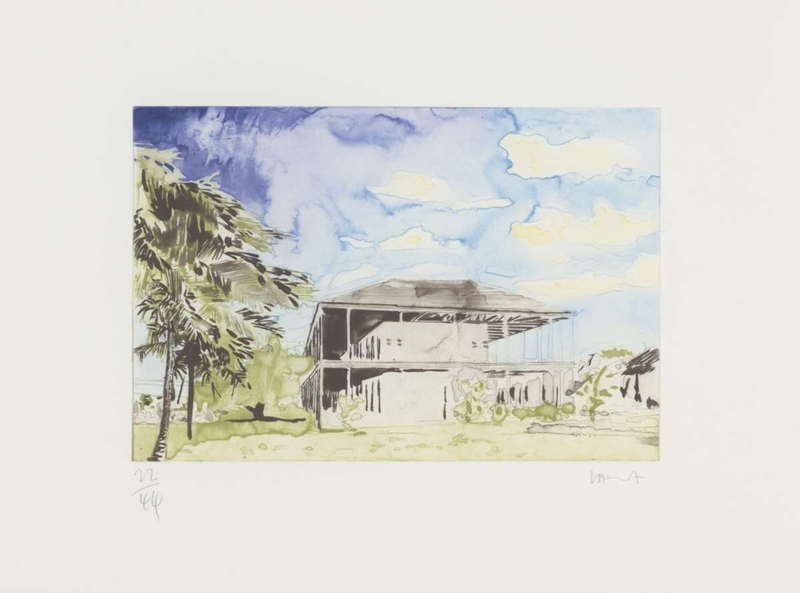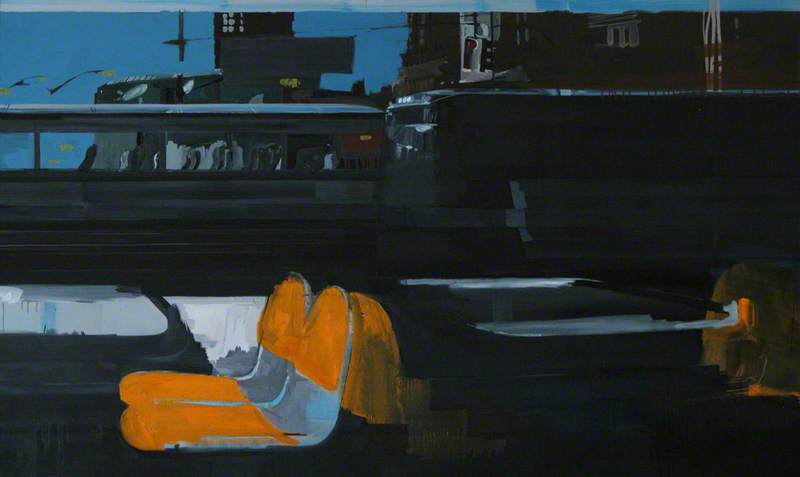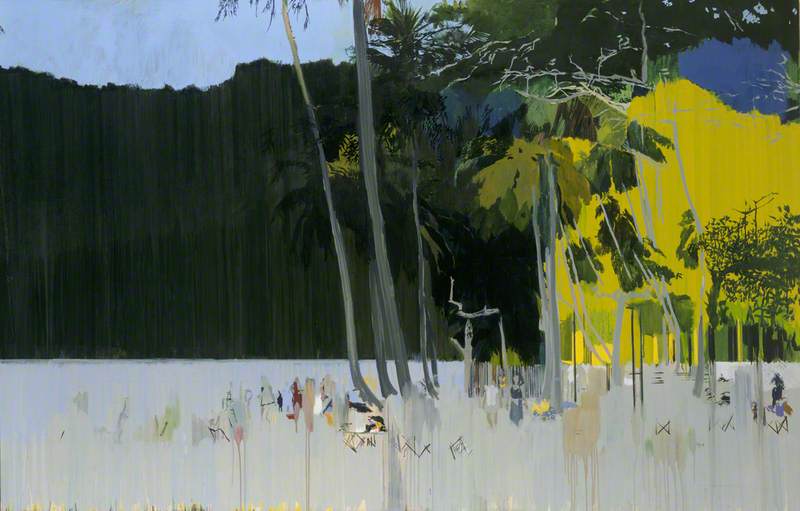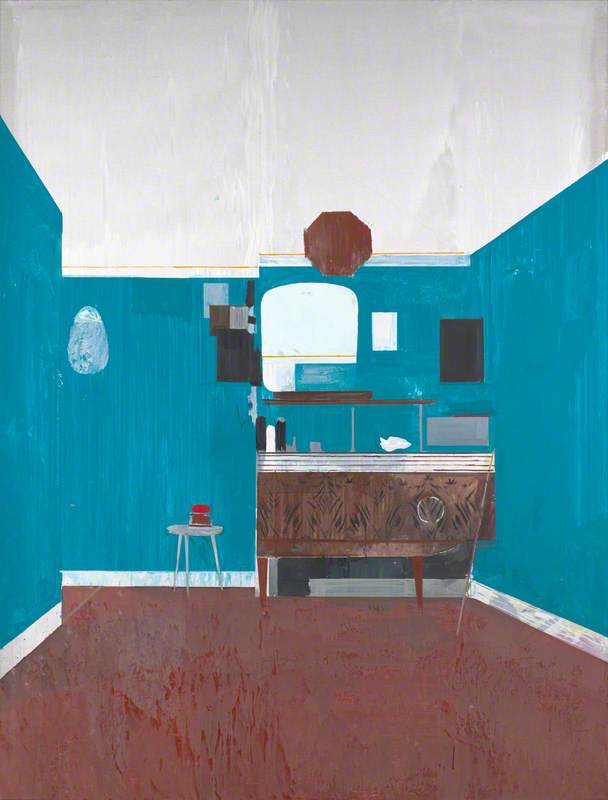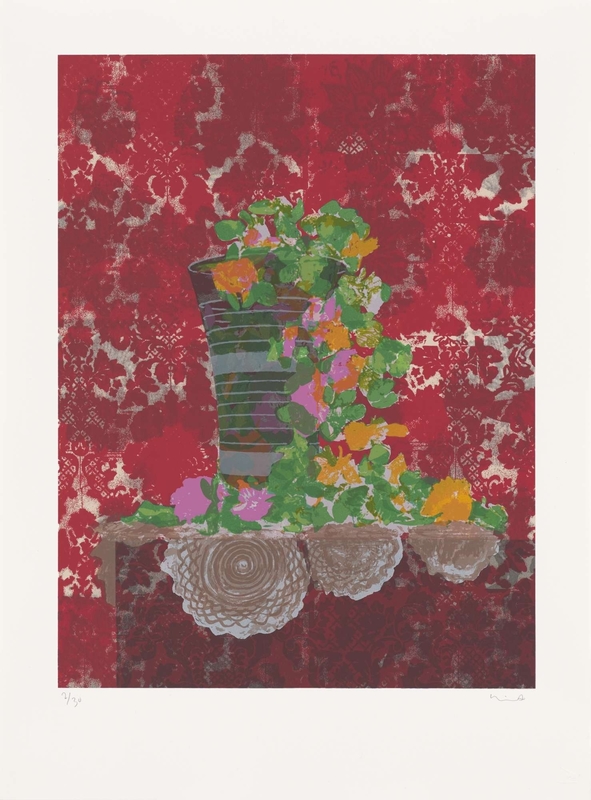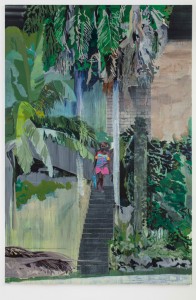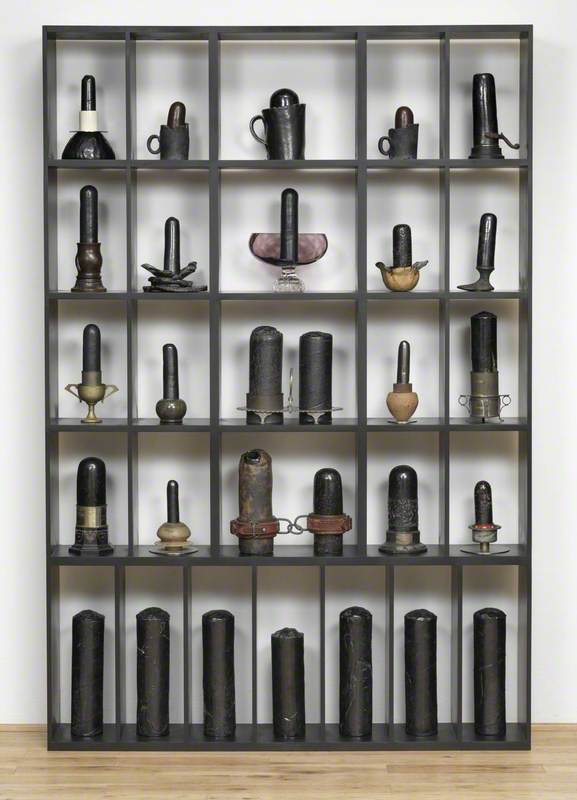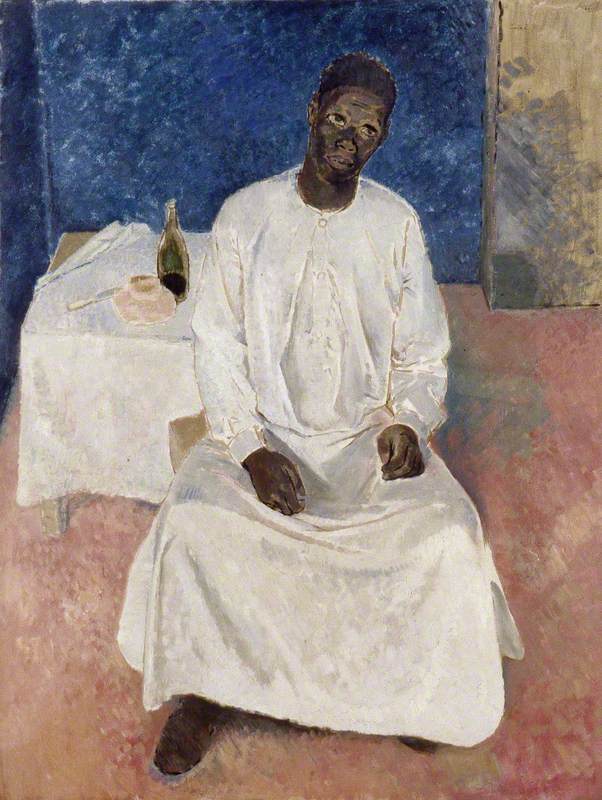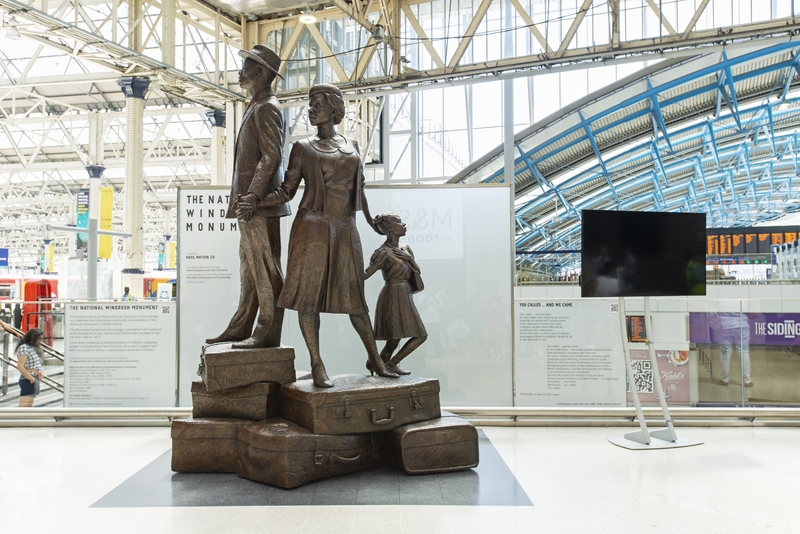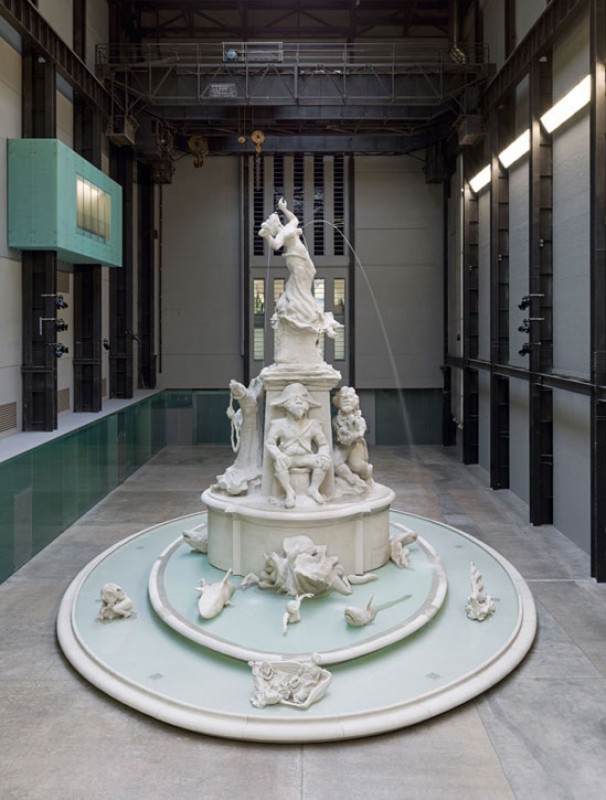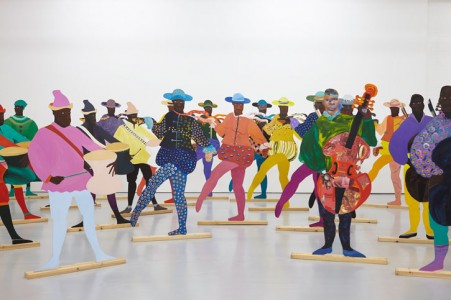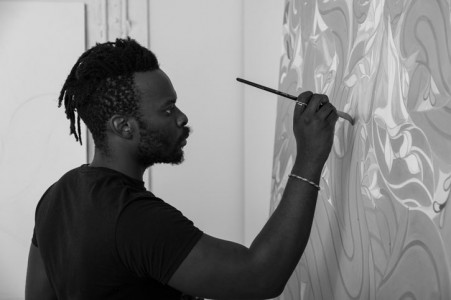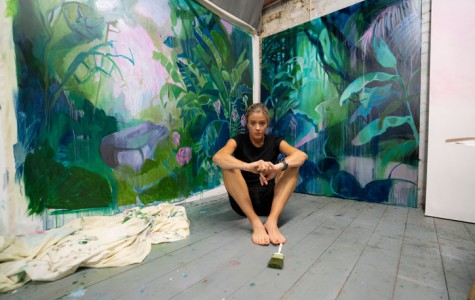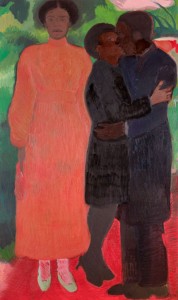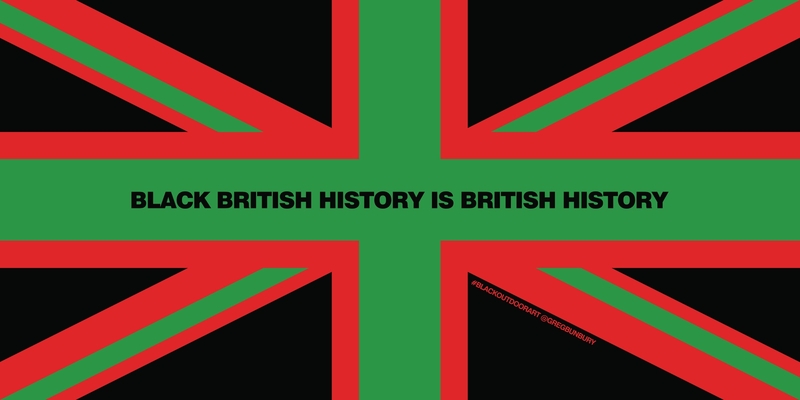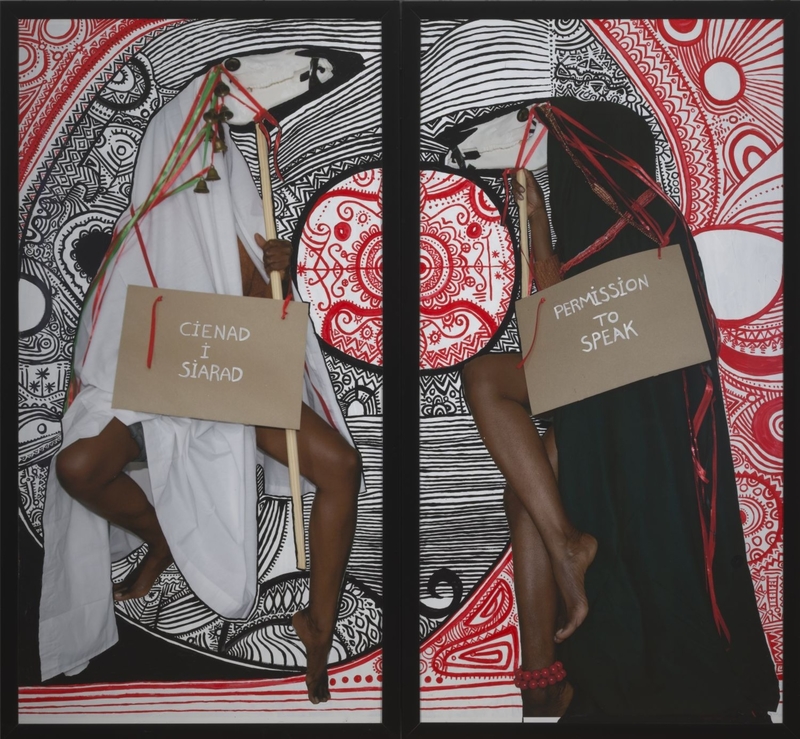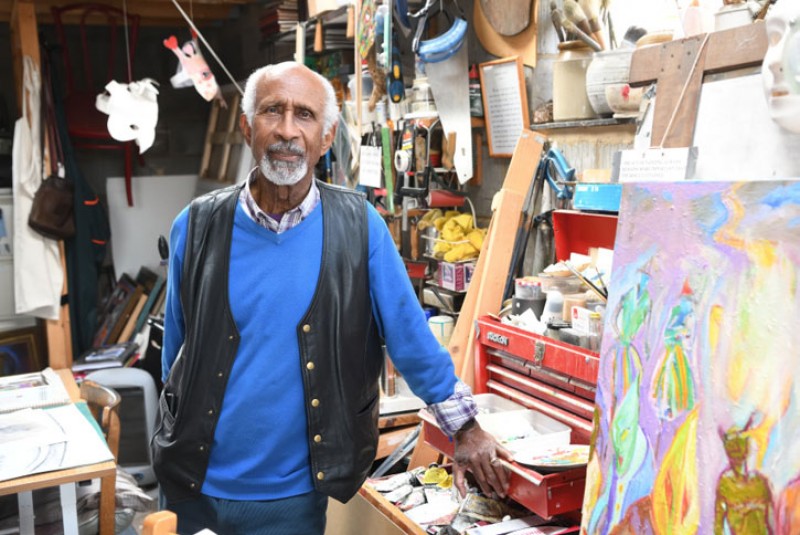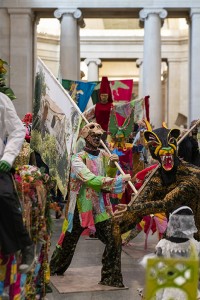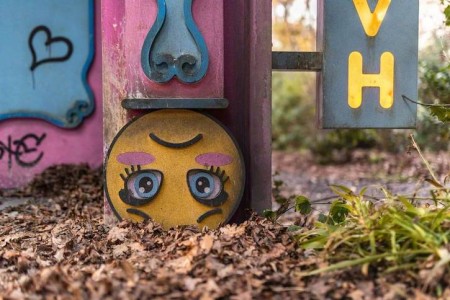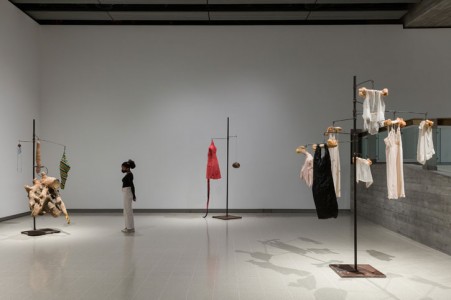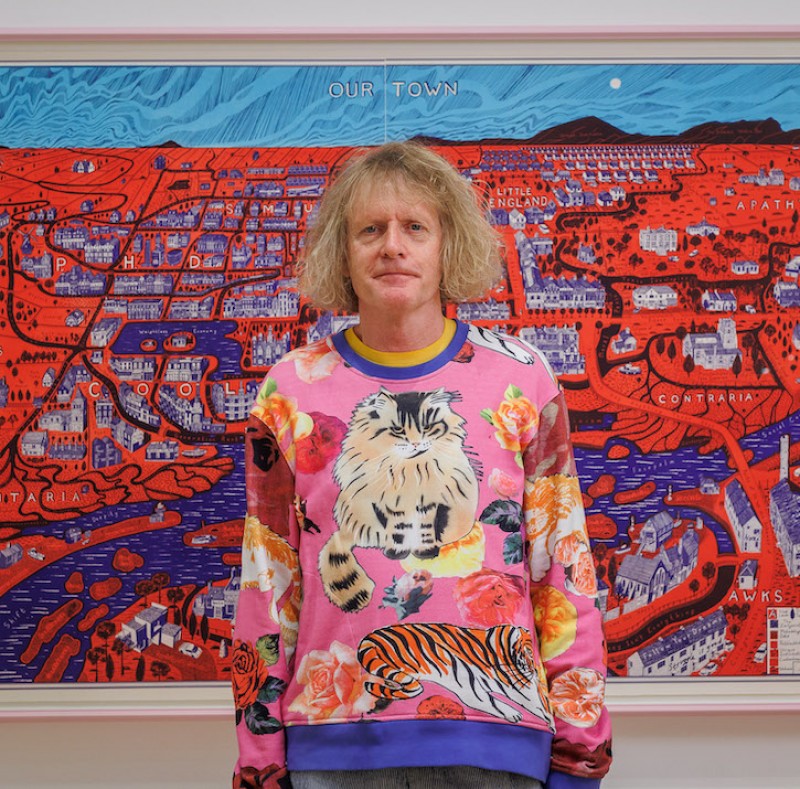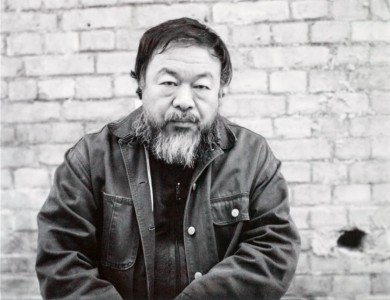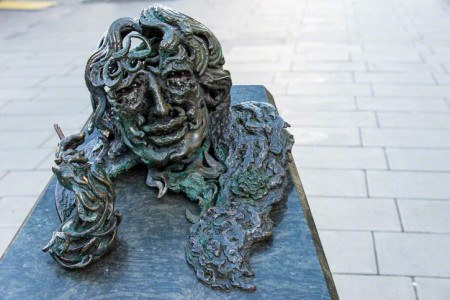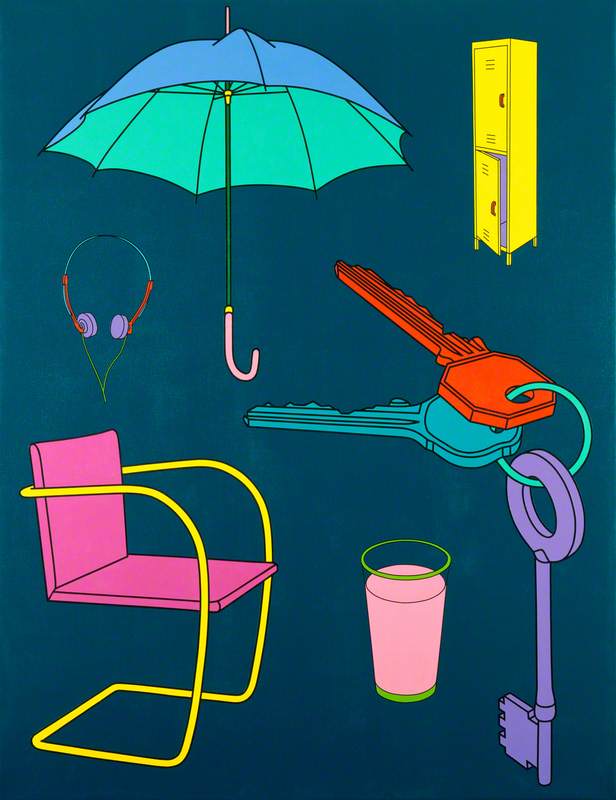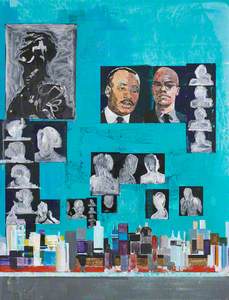Across his career, the British-born artist Hurvin Anderson (b.1966) has created works that consider the conditions of place, the operations of identity, and the contours of community and culture.
His paintings (for he is, by and large, a maker of images although he has produced sculptural and photographic work) are often marked by narrative mystery, inviting questions about meaning. The visual richness of his work, in terms of imagery and palette, attests to his thoughtful understanding of the long traditions of European and American landscape painting and reveals the originality of his thinking and material actions.
Lower Lake Drawing I
2005, acrylic and watercolour on paper by Hurvin Anderson (b.1959) 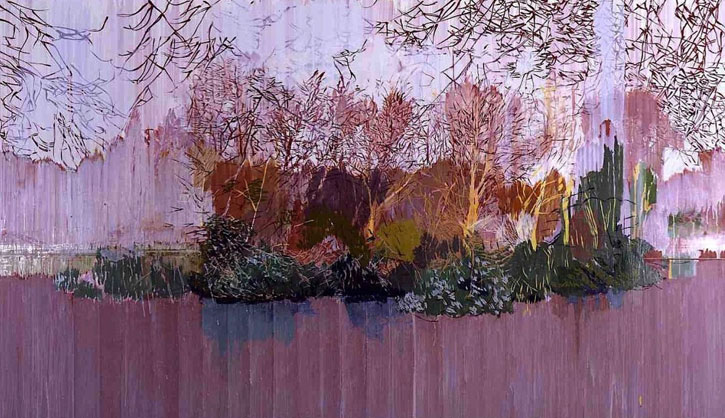
Anderson's practice is defined by its quiet, critical interrogation of the conditions of contemporary life in Britain and the Caribbean and what exists as the expanded postcolonial Atlantic world. Rightly, Anderson's work has often been described as postmodern in character because of its questioning of time and memory, its interrogation of colonialism and its complex and often challenging legacies.
Indeed, Anderson's work consistently turns on his determination to make images that speak about the forces and consequences of history in Britain and the Caribbean. As a maker of images as much known for their stillness as their beauty and often voluptuous palettes, Anderson is a painter whose command of the mechanics of his craft has pushed the boundaries of landscape painting (a historical term that does not adequately describe his subject matter). He has created a body of work that functions as a sustained, often temporally looping rumination on the complex conditions of selfhood and culture in the context of what can be described as postimperial globalism, with its complex flows of people, capital and ideas.
Hurvin Anderson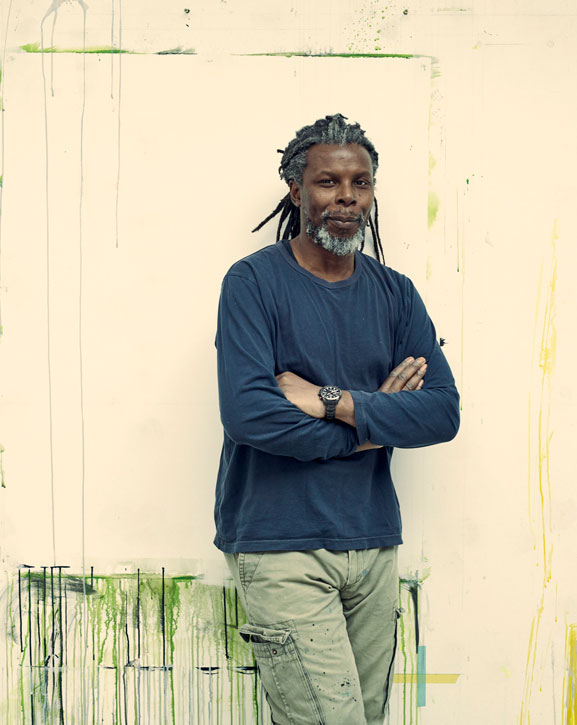
Born in Handsworth, Birmingham, Anderson was the youngest of eight children of Elsade and Stedford Anderson who emigrated to Britain from Jamaica in the early 1960s as part of the transformative 'Windrush Generation'. Anderson has, over the course of his career (one that despite his prodigious talents is problematically under-acknowledged by the British art establishment), sought to explore the capacity of painting as a tool of social critique.
Anderson's images – most often landscapes and depictions of the natural world where people are only occasionally visible – manage in quiet, shimmering and, at times, simmering ways, to consider issues of social and national character, the implications and power of place and the operations of history in the collective and often selective memory. Quietly central to Anderson's practice is his constant engagement with the complex aftermaths of decolonisation in the Atlantic world.
Anderson's interest in art began at an early age. In junior school, he was known for carrying his sketchbook with him, in which, as one of his teachers recalled, he tended to create images of Black superheroes and fantastical Afro-futurist worlds. As a student for whom school often proved difficult, Anderson found how art could serve as a means of communication. As a teenager, his brother Claude took him to see an installation of contemporary work by Black artists organised by the educator and activist Gilroy Brown and held in a church hall in Handsworth. The exhibition showed the work of about 120 makers and aimed to foster pride in Black history and culture as well as acknowledge the wide range of work made by Black artists in the Midlands. For Anderson, the exhibition was significant because it helped him realise the possibility of making a career as an artist.
It was around this time that Anderson became interested in photography. His brother Claude (also talented artistically), owned a prized camera which he taught Hurvin to use and allowed him to borrow. Anderson would regularly carry the camera with him when he went out, and he would take pictures of his neighbourhood and his friends. The immediacy of photography – and the opportunities it afforded of recording the world as encountered – would come to be a centrally important dimension of his image-making.
In fact, many of Anderson's paintings have their origins in his photographs (clearly documentary in character). One photograph in particular, taken in Handsworth Park, shows his mates lined up at the edge of a pond trying to figure out how to retrieve their errant, floating soccer ball. Years later, after he had completed his graduate studies at the Royal College of Art, the photograph – with its varied shades of green – became the basis for a series of paintings made in the late 1990s which, with the repeated but numerically differentiated title of Ball Watching, raised questions around the place of Anderson and his generation in Britain.
Ball Watching
1997, oil on canvas by Hurvin Anderson (b.1959) 
In these works, ideas are raised about what has been termed the 'double consciousness' of diasporic peoples and questions about belonging and place. In the several versions of the work, Anderson both paints directly from the image and modifies it in significant ways through changing the palette, the number of people and their spatial arrangements. In one muted black and grey painting, the willow trees and scrubby foliage on the far side of the pond are replaced with palm trees. In an instant, the leafy, far shore of a pond in a suburban park in Birmingham is transformed to a vista of cultural resonance of – and perhaps longing for – a distant and known place.
The economic realities of Britain in the late 1980s meant that Anderson had to find employment upon leaving school. He drove a van and made music. All the while, however, he maintained a studio space and continued with his practice. During this time, he also took courses at Birmingham Polytechnic and, with the aid of one of his instructors, he put together an application for the Fine Arts programs at the Wimbledon College of Art. He started his studies at Wimbledon in 1991 and among his mentors were George Blacklock and John Mitchell (with Mitchell helping him with his application to the Royal College of Art).
Anderson received his MA in 1998. Among the faculty that Anderson came to know was the painter Peter Doig, to whom Anderson's work is frequently (and inaccurately) compared.
Included in the works he showed for his graduate exhibition were a pair of paintings that showed the interior of a bus station in New York City (to which Anderson had travelled on a scholarship to investigate Black filmmakers. The works – one bluey-green and the other greys and oranges (Autorondec) – are cool, moody studies of the often-impersonal character of urban forms and the attending feelings of loneliness and alienation.
In the late 1990s, Anderson investigated subjects such as the life of Hailie Selassie, Rastafarianism and the career of the Jamaican political leader, nationalist and businessman Marcus Garvey (with several works focusing on Garvey's Black Star Line and the idea of the Black empowerment and history).
In Maracas II and Maracas III, Anderson goes to great lengths to capture and critique the redolent place of the Caribbean in the British imagination.
In Maracas II, Anderson's dreamy painting of a sandy beach and palm-edged shore not only acknowledge the ways that tropical islands have long served European fantasies of paradise but, at the same time, invites consideration of the often-overlooked histories of these places in imperial systems of commerce.
In the Welcome Series, Anderson similarly considers sites of social interaction in the Caribbean.
Welcome: Carib
2005, oil on canvas by Hurvin Anderson (b.1959) 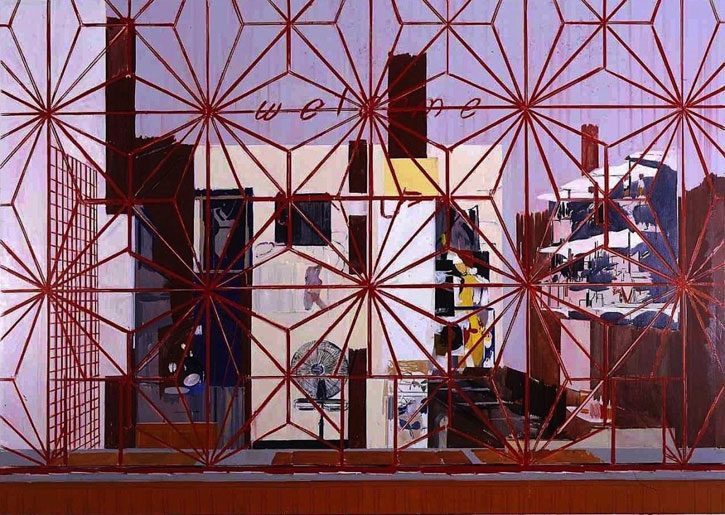
The artist shows the interior seen through an ornate metal security screen suggesting ideas of access and inclusion. But, as the painting has a powerful foreground image that must be looked past so as to see the room with its decorated walls, it engages the concept as well as the actuality of sight.
For although Anderson would resist identifying himself as a political painter, much of his work turns subtly on his considerations of identity and belonging. In 2005 Anderson embarked on making images of the interiors of Black barbershops.
These investigations were initiated by his returning to the attic shop of Peter Brown in Handsworth where he had gone as a child and from which he was collecting his elderly father, and also visiting a shop recommended when on a visit to Birmingham. The resulting two thematically and conceptually related series function as studies in the cultural specificity of these vital meeting places.
Peter Brown's Barbershop
2006, photocollage by Hurvin Anderson (b.1959) 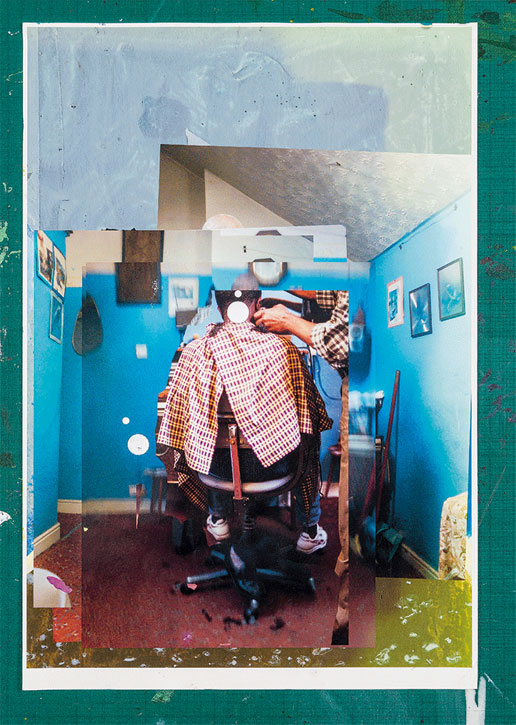
In the extensive Peter Series, Anderson focuses on the angular, intimate architecture of the attic room and uses colour – a palette of ochres, blues and whites that trigger thoughts of the British flag and nation – to interrogate ideas of place and identity.
In the related series, the more conventional storefront architecture of a barbershop takes a less prominent role in Anderson's compositions. Instead, he considers ideas of masculinity and camaraderie and how the shops function as the important sites of cultural identity and social performance.
In Jersey, two recently occupied but empty chairs anchor the painting at its visual mid-point.
A long, wall-mounted counter is cluttered with the barbers' equipment. The surface of the light blue mirror is punctuated by assorted, vertically arranged rectangles of different sizes and colours, capturing the promotional images of haircuts and memorabilia accumulated across time. Almost always devoid of people, Anderson's still life paintings of the interiors of barbershops, while referencing the European practice of the painting of domestic interiors, focus attention on the dignity and dynamics of Black space and, in doing so, initiates conversations about community and life in multicultural contemporary Britain.
However, while Anderson, by his own account, has not actively sought out a role as a political painter, his work is always layered in its meanings. Nowhere is this more evident in his 2015 work Is it OK to Be Black?
In this painting, with its questioning and vulnerable title, Anderson transforms the blank but unquestionably suggestive rectangles on a mirrored surface by filling them in with painted photographs of historical figures from the Black Diaspora.
Marcus Garvey is clearly present as are Malcolm X and Dr Martin Luther King. Among the more loosely rendered photographs, the figure of Muhammed Ali can be made out, his arms raised in victory, adding to the pantheon of Black achievement and the integrity of character. And here, in an instant, the picture's viewers are reminded of the costly struggles for human rights. In looking at Anderson's painting, viewers, in turn, are asked to consider their feelings about the questions of racism and equality.
The same motivations around depicting the experiences of the Black community in Britain are seen in quiet, undeniably tender ways in Still Life with Artificial Flowers (2018).
Commissioned by the Foreign Office for display in the nation's embassies around the world, Anderson's image of a vase of plastic flowers set against a background of flocked wallpaper not only honours his mother – the vase was one of the few objects she brought with her when she moved to Britain – but captures the symbolic power of the living room as the embodiment of middle-class material pride in the nation.
For Caribbean and other emigrant families, realties of the hostilities and prejudices of British society meant that the home served as an important sanctuary in the nurturing of the bonds of family. In Anderson's image, the vase sits as the embodiment of the familial and social achievements of his family across the decades since his parents came to Britain, but also to the shared values of British society.
In sum, Anderson is an artist who has, in quiet and powerful ways, opened up a critical space for the consideration of the conditions of contemporary Britain. His work invites viewers to think about the operations of history – national, imperial, colonial and postcolonial – and the role that history places in everyday life.
Michael Prokopow, author of Hurvin Anderson published by Lund Humphries
